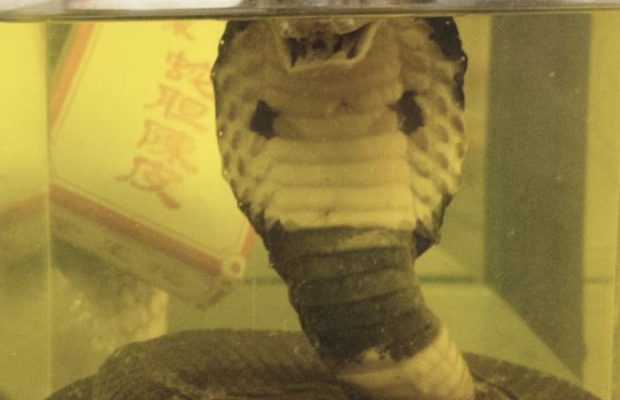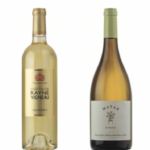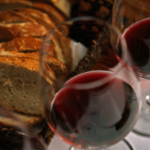Good Snake Wine Should Taste Like a Meal in a Shot Glass

Lady Gaga’s Bad Romance is playing in the background. She is weirdly popular in a country where most of the population can’t understand the lyrics of her songs, and our unseen protagonist hums along at random intervals. Seven or eight clear plastic bottles are clustered on an apartment floor, each containing wolfberries and ginseng. Coiled atop the roots and berries are snakes, and one by one the bottles are filled with a clear liquor. Then we realize that the snakes are alive, being drowned, then entombed for their essence like the victims of Jean-Baptiste Grenouille. Some snakes are confused; others struggle in their final alcoholic moments, flicking and turning and struggling against the clear plastic walls.
The makeshift production isn’t an uncommon thing in China, where tradition often trumps logic when it comes to food. In this case, the risks are obvious: some snakes survive for months in the bottles, and sink their fangs into whomever awakens them from their drunken slumber. The snakes also often have parasites within their bodies, so if they’re not gutted and cleaned properly, drinking homemade snake wine can be lethal. People in China have died from both causes, but some still prefer a hands-on approach, macaution be damned.
The amateur efforts in snake wine tincturing at home are a little weak, so I sought out some professionals who know what they’re doing. The Cheung family runs two snake soup shops in Hong Kong, and their franchise is called Sher Wong Yip. Aside from the standard cooked dishes made from snake flesh and snake bones, they also make snake wine.
As everybody else in the restaurant slurped a local specialty—thick, slimy, aromatic snake soup—a waitress poured me just about a double shot and told me to sip it slowly, bit by bit. The first sip was very, very smooth. No burn. Almost sweet, but more like a chrysanthemum rather than a spoon of honey. The second sip was refreshing. There were hints of slivered lemon leaves and my mouth felt clean. The third was salty. The fourth, about halfway through the glass, was saltier still, almost fleshy and ocean-like. It carried an amphibious flavor—a little bit of seawater, a little bit of earthiness. And then the burn kicked in. As I finished the second half of the snake wine that was presented to me, I was hit with a stronger citrus punch. Then they showed me how they made it.
The idea that snakes are some kind of miracle meat is rooted in old texts that have little value, and firmly embedded within the culture of East and Southeast Asia in a superstitious, even destructive way.
Gibson Cheung, the son in the proprietary family, explained that his father made that batch decades ago, before Gibson was even born. Beside a squirt bottle containing some kind of chemical cleaning agent, Gibson showed me 65-proof rice wine—just a notch weaker than vodka but still packing a punch, usually consumed in massive quantities during over-the-top marathon nighttime meals. The wine has been in the same large glass Chinese medicine jar as some herbs, coiled cobras and… geckos. Lots of geckos. A visually disturbing cluster of geckos, their corpses suspended in the amber liquid that raced down my gullet mere moments ago.
The snake wine was like a meal in a shot glass, but it actually tasted alright. A good snake wine shouldn’t have a medicinal taste, and the 30-plus-year cobra and gecko tincture made by Gibson Cheung’s father actually reminded me of a spiked version of the salted lemonade that is served in Thailand.
In Chinese tradition, snakes—in food and in wine—are good for a lot of things: vision, throat sores, rheumatism, digestion, cholesterol, hearts and lungs, nerves, fatigue, blood, immunity, and so on, and so on, and so on. Some also claim that it’s great for your sex drive, but nobody shared that tidbit with me in Hong Kong.
So snake wine is believed to be medicinal even though it’s not medicine. It’s true that snake meat is low in fat and calories, and high in protein. As a replacement for chicken, it’s great. But none of the claims made by practitioners of traditional Chinese medicine have been backed up by scientific or medical studies. It is telling that most local pharmacies, even those that peddle things like dried seahorses and useless herbal pills that are made in China, don’t carry any snake parts for sale. The idea that snakes are some kind of miracle meat is rooted in old texts that have little value, and firmly embedded within the culture of East and Southeast Asia in a superstitious, even destructive way.
Yet snakes capture our imagination. Mythical Asian dragons take the form of large, powerful snakes. Buddha, in legend, meditated as a great storm rolled toward him. A naga king gave shelter to Siddhartha and acted as his protector. Statues of Buddha are often depicted as cocooned by a seven-headed king cobra, as seen in Cambodia, Laos, Thailand, and other lands nearby. If snakes have power, then there’s something primal in the act of consuming them, drawing out their essence and making it part of ourselves.
In truth, bottled snake wine usually isn’t sold with the actual snakes (or geckos) in it. The showpieces with full-hooded cobras, scorpions, and other creepy-crawlies seeping in spirits are more for show. Tourists pick them up as they traverse the Mekong nations. It somehow makes their trips a bit more interesting, a bit more worthy of dinner party banter at a later date.
In reality, for the everyday local consumers, snake wine is sold like any other type of spirit: free of its solid ingredients. It’s inoffensive, served neat like in the shot glass I used. Ads for snake wine in the 1980s and 1990s were just like any other advertisement for alcohol. Tamer than usual, even. For a lot of people, it’s meant as a drink to be revisited regularly. But will I, geckos and all? Maybe, but not anytime soon.
Click here to view original web page at munchies.vice.com



















